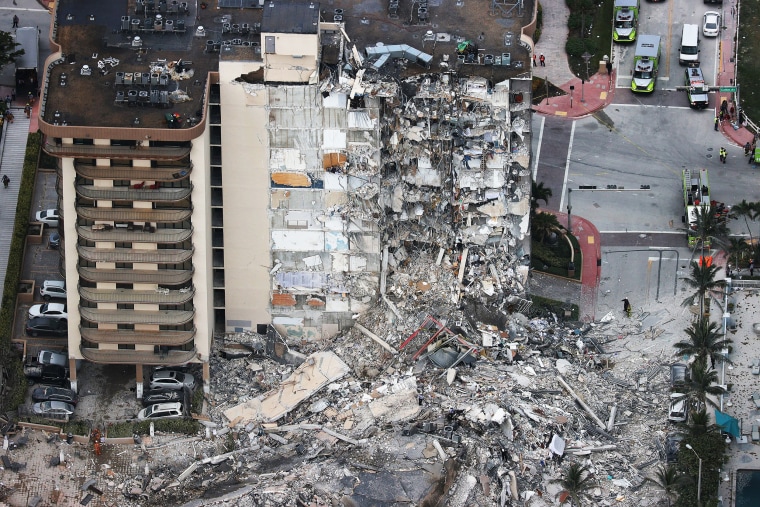There are more questions than answers after a 12-story building collapsed in Surfside, Florida, Thursday, leaving at least four people dead and 11 injured. More than 150 people are still unaccounted for in the small Miami Beach community.
Local officials appeared to have few ideas so far about what may have caused the 136-unit building to inexplicably crumble. Scientists, however, have long noted the risk of building on the shifting sands of a barrier island like Miami Beach, especially with rising sea levels. That may not be the reason for this collapse, but it remains an engineering challenge in the region.
Surfside’s mayor, Charles Burkett, told reporters that he often jogged by the condo building, which was built in the early 1980s. He said he knew it had undergone some minor construction and roof work that included a recent crane, but he noted that many buildings undergo similar maintenance.

“There’s no reason for this building to go down like that,” Burkett said, “unless someone literally pulls out the supports from underneath, or they get washed out, or there’s a sinkhole or something like that, because it just went down.”
"I mean it looks like a bomb went off, but we're pretty sure a bomb didn't go off," the mayor told NBC’s “TODAY” show.
‘Buildings don’t just collapse’
Kenneth Direktor, an attorney for Becker, a law firm that has worked for the building since 1993, told the Miami Herald that the building had hired an engineer to undergo a 40-year recertification process, as is required under Miami-Dade County building code.
“They were well into the review with the engineer about the project,” Direktor told the Miami Herald.
Any property in the county that was built four decades or longer ago is required to complete the inspection process within a few years of that anniversary to certify “each building or structure is structurally and electrically safe for the specified use for continued occupancy,” according to the county’s notice sent to property owners.
There are recent examples of the local government shutting down condo buildings in Miami Beach and forcing residents to move out if they fail their inspections, said Peter Zalewski, principal of Condo Vultures, a South Florida real estate market analysis company. Miami Beach closed the Castle Beach Club to residents for more than two years in 2005 after the building failed to address structural damage and electrical defects, he said.
“I’ve been here since 1993, and I’ve never seen something like this happen,” Zalewski added, referring to Thursday’s condo collapse. “You would think any problems that large would have been detectable. If a recertification was being done, expect reports that say what problems currently exist in the building.”
“I have a feeling that something else is going to be discovered that happened that we can’t assume right off the bat,” Zalewski added. “Forty-year-old buildings don’t just collapse, and there’s a whole series of them lining up and down the coast.”
Public records did not show many issues regarding the building beyond two lawsuits over cracks in a unit’s exterior wall.
One condo owner sued the unit association for failing to fix the cracks in the outside wall of her unit in 2015, according to a lawsuit filed in Miami-Dade County. The condo owner, who could not be reached for comment, said the cracks led to water damage that cost $15,000. The court documents noted that because the cracks were a structural issue the building association was liable for the expense.
The condo owner had previously filed a lawsuit against the building association in 2001 due to a similar issue. The two sides settled outside of court, but that kind of cracking is described as “of interest” in the county’s Structural Recertification Form.
Becker, the law firm that works for the building and represented it in the 2015 lawsuit, did not provide a response to a request for comment.
‘A real awakening’
Another issue at hand for the Surfside community is one shared with all of Miami Beach: The towns are built on a barrier island. Climate scientists and geologists have long warned that these islands cannot be developed responsibly. They are made of a loose mixture of sand and mud and provide a natural protection for the shoreline.
“These are very dynamic features. We didn’t understand that these islands actually migrate until the 1970s,” said Orrin Pilkey, a professor emeritus of geology at Duke University who has long studied sea-level rise and the over-development of the coast. “As sea level rises, they move back.”
An analysis of satellite images taken of Miami Beach, which includes the town of Surfside, found that the area had moved slightly each year through the 1990s, according to a study published in the journal Ocean & Coastal Management in April 2020. The report noted that these issues can lead to greater flooding and hazards for local communities.
Americans have built approximately $3 trillion worth of property on barrier islands and coastal floodplains, according to “The Geography of Risk,” a book by Pulitzer Prize winner Gilbert Gaul that analyzes the real estate investment in beach communities over the past century.
“It’s a tough conversation to have, but the building shouldn’t have been there,” Pilkey said, “along with a lot of other buildings. We’re due for a real awakening.”
In the meantime, Zalewski said he believes buildings of a similar age will probably undergo fresh analyses and inspections in the aftermath of this tragedy. He said he wouldn’t be surprised if Florida began requiring building reports to be handed to the state for review in the future.
“At the end of the day,” he said, “this is going to be a dramatic change for condos.”

